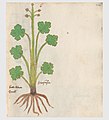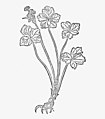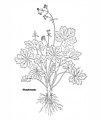Forest sanicle
| Forest sanicle | ||||||||||||
|---|---|---|---|---|---|---|---|---|---|---|---|---|

Forest Sanikel ( Sanicula europaea ) |
||||||||||||
| Systematics | ||||||||||||
|
||||||||||||
| Scientific name | ||||||||||||
| Sanicula europaea | ||||||||||||
| L. |
The forest Sanikel or short Sanikel , including forest burdock called ( Sanicula europaea ) is a species within the family of Umbelliferae (Apiaceae). It thrives in forests in large parts of Eurasia and North Africa .
description
The forest sanicle grows as a wintering green, perennial herbaceous plant and reaches heights of 20 to 60 centimeters. The basal leaves are dark green and serrate on the edge. The teeth of the leaf margin have an awn-like tip. The stem has only a few leaves or is completely leafless.
The flowering period extends from May to June, the fruit ripening from August to October. It is - atypical for umbelliferous plants - a not strictly double-gold , somewhat irregular inflorescence . Both the umbel and the umbel are provided with bracts. The nodules are more or less hemispherical in shape. The flowers are white (rarely pink). The double achenae are about 4 to 5 mm long, brown-black and densely covered with hooked spines.
The species has chromosome number 2n = 16.
ecology
The forest sanicle is a hemicryptophyte .
In terms of flower ecology, it is a matter of "nectar-bearing disc flowers". The forest sanicle is pollinated by insects , on the one hand, and self-pollination on the other .
The hooked, thorny double achenes disintegrate into the two partial fruits without the fruit carriers. The diaspores spread as Velcro fruits ( epizoochory ) or by the wind. The fruits are winter dwellers .
The forest sanicle can be attacked by the rust fungus Puccinia saniculae .

Occurrence
The forest sanicle is widespread in Europe , North Africa , Asia Minor , Caucasus , Iran and Siberia . It is native to Europe from the Mediterranean to Scandinavia. In Central Europe it occurs scattered.
The forest sanicle is widespread in Germany, but occurs rather scattered. Only in north-west Germany and low-lime mountain ranges is it to be found less often or completely absent. In the Allgäu Alps, the species rises in Tyrol between Elbigenalp and Bernhardseck up to 1500 m above sea level.
Sanicula europaea thrives individually in shaded, fresh to moderately dry, mostly lime-rich , alkaline sites, mostly on loam , and more rarely on silt soils . It grows preferentially in beech and hornbeam forests, more rarely in (dry) floodplain forests. In Central Europe it is a Fagetalia order character.
Taxonomy
The scientific name Sanicula europaea was first published in 1753 by Carl von Linné in Species Plantarum .
pharmacology
As the name Sanikel (Middle High German die or sanikel / sanickel , from Middle Latin sanicula from sanare "heal", with suffix - [i] cul : "the little healer") emerges, this species is already long used as a medicinal plant. The basal leaves (Sanicula herba) collected and dried at the time of flowering serve as a medicinal drug .
The following are mentioned as active ingredients: triterpene saponins , acylsaniculosides with barrigonols as aglyka , Laniaceen tannins such as rosmarinic and chlorogenic acids , flavonoids and organic acids . However, tannins and allantoin could not be found, although this is still sometimes claimed.
The forest-Sanikel, also called Rupturewort , salvation of all damage and Wundsanikel , was formerly almost seen as a "panacea". Today one mainly only uses the expectorant effect of the plant ingredients , which is due to the saponins , in the case of slight catarrh of the respiratory tract.
history
In the Physica manuscripts of the 14th and 15th centuries attributed to Hildegard von Bingen , the forest sanicle - under the name "sanicula" - was first described as a medicinal plant. According to the theory of humours , it was classified as "warm". Its juice was judged to be pleasantly tasting and wholesome as well as beneficial for the sick stomach and the sick intestines. The greening plant should be pulled out by the roots, boiled in water and sifted. Honey and a little liquorice should be added to the sieved so that a honey spice is created. In order to remove mucus from the stomach and heal the sick viscera, this potion should be taken often after breakfast. Forest sanicle, slowly dried in the sun and lightly powdered, was to be kept for the winter and to be used as freshly prepared. Anyone who has been injured by iron (cuts and stab wounds) should take the fresh juice of the plant or the dried powder in water after breakfast. The injuries would slowly heal from within.
A "Wilder Sanikel" occurring in medieval texts is possibly the same species, formerly also called "White Sanikel". Other plants such as wood anemones , gray alpine easter , green alpine eagle and a whole range of other plants can also be considered.
In the Mainz Garden of Health (1485), Erhard Reuwich depicted the forest sanicle true to life for the first time. In the text of the "Gart" (Chapter CXLVIII) the forest sanicle was named next to sanickel , ferraria maior and consolida minor as well as diapensia . This pointed to its wound healing effect. The daisy was also included in the “consolida minor” category . The "Gart" quoted the Physica text almost completely - without citing the source - and added a recipe for the production of a wound potion that was supposed to dissolve blood that has clotted in the body. To prepare this potion wound Sanicula europaea were Pyrola rotundifolia and lady's mantle to boil in wine.
In the chapter "From Sanickel water" his little Destillierbuchs from 1500 mentioned Hieronymus Brunschwig first time the wood anemone .
swell
- Latin Middle Ages: Hildegard von Bingen 12th century --- Garden of Health 1485 --- Hieronymus Brunschwig 1500
- Modern times: Otto Brunfels 1532 --- Hieronymus Bock 1539 --- Leonhart Fuchs 1543 --- Pietro Andrea Mattioli 1586 --- Tabernaemontanus 1588 --- Nicolas Lémery 1699/1721 --- Commission E 1986
Historical illustrations
Vitus outlet 1479
Garden of Health 1485
Otto Brunfels 1532
Leonhart Fuchs 1543
Hieronymus Bock 1546
Mattioli / Handsch / Camerarius 1586
swell
literature
- Henning Haeupler, Thomas Muer: picture atlas of the fern and flowering plants of Germany . Ed .: Federal Agency for Nature Conservation (= The fern and flowering plants of Germany . Volume 2 ). Eugen Ulmer, Stuttgart (Hohenheim) 2000, ISBN 3-8001-3364-4 .
- Wolfgang Adler, Karl Oswald, Raimund Fischer: Excursion flora of Austria . Ed .: Manfred A. Fischer. Eugen Ulmer, Stuttgart / Vienna 1994, ISBN 3-8001-3461-6 .
- Christian Heitz: School and excursion flora for Switzerland. Taking into account the border areas. Identification book for wild growing vascular plants . Founded by August Binz. 18th completely revised and expanded edition. Schwabe & Co., Basel 1986, ISBN 3-7965-0832-4 .
- Erich Oberdorfer : Plant-sociological excursion flora . With the collaboration of Theo Müller. 6th, revised and expanded edition. Eugen Ulmer, Stuttgart (Hohenheim) 1990, ISBN 3-8001-3454-3 .
- Konrad von Weihe (ed.): Illustrated flora. Germany and neighboring areas. Vascular cryptogams and flowering plants . Founded by August Garcke. 23rd edition. Paul Parey, Berlin / Hamburg 1972, ISBN 3-489-68034-0 .
Web links
- Forest sanicle. In: FloraWeb.de.
- Distribution map for Germany. In: Floraweb .
- Sanicula europaea L., map for distribution in Switzerland In: Info Flora , the national data and information center for Swiss flora .
- Sanicula europaea L. In: Info Flora , the national data and information center for Swiss flora .
- Distribution in the northern hemisphere from: Eric Hultén, Magnus Fries: Atlas of North European vascular plants. 1986, ISBN 3-87429-263-0 at Den virtuella floran. (swedish).
- Sanicula europaea as a medicinal plant
Individual evidence
- ↑ Entry in the Lexicon of Medicinal Plants and Drugs on Spektrum.de
- ↑ Waldklette on remedia.at
- ↑ a b c d e Wald-Sanikel. In: FloraWeb.de.
- ↑ a b c d e Ruprecht Düll , Herfried Kutzelnigg : Pocket dictionary of plants in Germany and neighboring countries. The most common Central European species in portrait . 7th, corrected and enlarged edition. Quelle & Meyer, Wiebelsheim 2011, ISBN 978-3-494-01424-1 , p. 700-701 .
- ↑ a b Erich Oberdorfer : Plant-sociological excursion flora for Germany and neighboring areas . 8th edition. Stuttgart, Verlag Eugen Ulmer, 2001. ISBN 3-8001-3131-5
- ↑ Peter Zwetko: The rust mushrooms Austria. Supplement and host-parasite directory to the 2nd edition of the Catalogus Florae Austriae, III. Part, Book 1, Uredinales. (PDF; 1.8 MB).
- ^ Sanicula in the Germplasm Resources Information Network (GRIN), USDA , ARS , National Genetic Resources Program. National Germplasm Resources Laboratory, Beltsville, Maryland. Retrieved May 27, 2018.
- ↑ Erhard Dörr, Wolfgang Lippert : Flora of the Allgäu and its surroundings. Volume 2, IHW, Eching 2004, ISBN 3-930167-61-1 , p. 261.
- ↑ Carl von Linné: Species Plantarum. Volume 1, Lars Salvius, Stockholm 1753, p. 235 ( digitized ).
- ↑ a b c Ingrid Schönfelder, Peter Schönfelder : The new manual of medicinal plants. Special edition. Franckh-Kosmos, Stuttgart 2011, ISBN 978-3-440-12932-6 .
- ^ Heinrich Marzell : Our medicinal plants: Their history and their position in folklore. 2. On. (under the title History and Folklore of German Medicinal Plants ), Stuttgart 1938, pp. 140–144.
- ↑ Irmgard Müller, Christian Schulze, Sven Neumann: Hildegard von Bingen. Physica. Edition of the Florentine manuscript (Cod. Laur. Ashb. 1323, approx. 1300) in comparison with the textual constitution of the Patrologia Latina (Migne). Olms, Hildesheim 2008, ISBN 978-3-487-13846-6 , p. 35.
- ↑ Heinrich Marzell : Dictionary of German plant names. 5 volumes, Leipzig, from volume 3 Stuttgart / Wiesbaden, volume 1, p. 117 f. and 290, Volume 2, p. 688, and Volume 5, p. 473.
- ↑ Peter Riethe : Hildegards von Bingen “Liber simplicis medicinae” in the Mainz “Garden of Health”. In: Sudhoff's archive. Volume 89, No. 1, 2005, p. 117.
- ↑ Hildegard von Bingen , Physica , Book I, Chapter 45. Edition. Charles Victor Daremberg and Friedrich Anton Reuss (1810–1868). S. Hildegardis Abbatissae Subtilitatum Diversarum Naturarum Creaturarum Libri Novem. Migne, Paris 1855. Sp. 1146–1147: Sanicula (digitized)
- ↑ Gart der Gesundheit . Mainz 1485, chapter 148: Diapensia, sanickel digitized
- ↑ Hieronymus Brunschwig . Small distilling book . Strasbourg 1500, sheet 103v-104r: Sanickel (digital copy )
- ↑ Otto Brunfels . Contrafeyt Kreueterbuch. Strasbourg 1532, p. 16: Sanickel (digitized version )
- ↑ Hieronymus Bock . Kreuterbuch. Strasbourg 1539, p. 151r (Part I, Chapter 173): Sanickel (digitized version )
- ↑ Leonhart Fuchs . New Kreütterbuch. Strasbourg 1543, chapter 260: Sanickel (digitized version )
- ^ Pietro Andrea Mattioli . Petri Andreae Matthioli medici senensis Commentarii, in libros sex Pedacii Dioscoridis Anazarbei, de medica materia. Translation by Georg Handsch, revised by Joachim Camerarius the Younger . Johan Feyerabend, Franckfurt am Mayn 1586, sheet 353v – 354r: Sanickel (digitized)
- ↑ Jacobus Theodorus , Neuw Kreuterbuch. Nicolaus Basseus, Franckfurt am Mayn 1588, pp. 302–306: Sanickel (digitized version )
- ↑ Nicolas Lémery . Dictionnaire universel des drogues simples. Laurent d'Houry, Paris, 1699, p. 684: Sanicula (digitized) . Translation. Complete material lexicon. Initially drafted in French, but now after the third edition, which has been enlarged by a large [...] edition, translated into high German / By Christoph Friedrich Richtern, [...]. Johann Friedrich Braun, Leipzig 1721, column 999: Sanicula (digitized version)
- ↑ Monograph of Commission E of the former Federal Health Office. Federal Gazette from 09/24/1986 (digital version )







